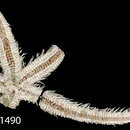Comprehensive Description
(
الإنجليزية
)
المقدمة من Smithsonian Contributions to Zoology
Luidia sagamina Doderlein
Luidia sagamina Doderlein, 1920:290, fig. 37.
Luidia aciculata Mortensen, 1933a:425, fig. 7, pl. 20; figs. 7–12.
Luidia sagamina aciculata.–Madsen, 1950:199, figs. 6–7.
There are five long arms, and the skeleton is moderately compact, the body flat. The paxillae are in irregular longitudinal and transverse rows, with a short, stout central spinule and 6 or 7 glassy, very thorny peripheral spinules. The inferomarginal plates have 2 or 3 long, rough-textured marginal spines, usually alternating 2–3–2–3. The upper spine is longest and is usually black at the base; paxillae also are mostly black. The channels between the inferomarginals are wide, bordered by long, fine spinules. The adambulacral plates have one slender, curved furrow spine, not flattened, and one other very much larger, long, acute, evenly tapered spine. There is only one actinal interradial plate, which bears a large three-valved pedicellaria; the valves of the pedicellariae are somewhat flattened at the tip. The jaws are armed with 4–6 long, rough spines and within the peristome on each side are two small, subequal blunt spines arising from a common furcate base. The madreporite is concealed by paxillae.
The distribution of this species is of considerable interest. Previously, it was known only from Sagami Bay, Japan (the type locality); Durban, South Africa; St. Helena; from Gaboon to Senegal in tropical West Africa; and the Cape Verde Islands. Madsen (1950) states that he could find no difference between the Japanese L. sagamina and Mortensen’s (1933) L. aciculata from St. Helena, but kept them separate for geographical reasons only. With this further extension of range, I do not believe such separation is justifiable. Although not common, L. sagamina may have a nearly worldwide distribution. A possible clue as to how this species became so widely distributed may be found in a report by Tokioka (1942) of a gigantic Luidia bipinnaria (12 mm) taken in the plankton near Seto, Japan. Mortensen (1939) stated that luidiids of the ciliaris group (to which L. sagamina belongs), with very large bipinnariae, have a free-swimming larval planktonic life of some months. These bipinnariae are, moreover, active swimmers, and it is possible that under particularly favorable conditions of currents, wind, etc., large actively swimming larvae could become very widely distributed, even though the adults are rather rare. Another specimen, examined after the above description was written, has been collected by the Duke University R/V Eastward off North Carolina.
MATERIAL EXAMINED.–Silver Bay Station 1515 (1) [R=8 mm, r=3 mm, Rr=1:2.5].
- الاقتباس الببليوغرافي
- Downey, Maureen E. 1973. "Starfishes from the Caribbean and the Gulf of Mexico." Smithsonian Contributions to Zoology. 1-158. https://doi.org/10.5479/si.00810282.126
Validity
(
الإنجليزية
)
المقدمة من World Register of Marine Species
Probably conspecific with Luidia alternata var. bicolor Verrill, 1915. However, the name bicolor antedates sagamina but the type is lost, preventing positive synonymy. Suppression of the name by the ICZN is desirible according to A.M. Clark (1982).
- ترخيص
- cc-by-4.0
- حقوق النشر
- WoRMS Editorial Board

